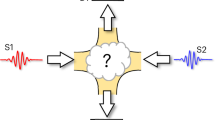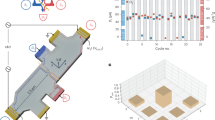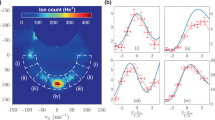Abstract
The indistinguishability of identical quantum particles can lead to quantum interferences that profoundly affect their scattering1,2. If two particles collide and scatter, the process that results in the detection of the first particle in one direction and the second particle in another direction interferes quantum mechanically with the physically indistinguishable process where the roles of the particles are reversed. For bosons such as photons, a constructive interference between probability amplitudes can enhance the probability, relative to classical expectations, that both are detected in the same direction — this is known as ‘bunching’. But for fermions such as electrons, a destructive interference should suppress this probability (‘anti-bunching’); this interference is the origin of the Pauli exclusion principle, which states that two electrons can never occupy the same state. Although two-particle interferences have been shown for colliding photons3,4, no similar demonstration for electrons exists2,5,6. Here we report the realization of this destructive quantum interference in the collision of electrons at a beam splitter. In our experiments, the quantum interference responsible for the Pauli exclusion principle is manifest as the suppression in electron current noise after collision.
This is a preview of subscription content, access via your institution
Access options
Subscribe to this journal
Receive 51 print issues and online access
$199.00 per year
only $3.90 per issue
Buy this article
- Purchase on Springer Link
- Instant access to full article PDF
Prices may be subject to local taxes which are calculated during checkout



Similar content being viewed by others
References
Feynman, R. P., Leighton, R. B. & Sands, M. The Feynman Lectures on Physics, Vol. 3; Quantum Mechanics (Addison-Wesley, New York, 1965).
Loudon, R. in Coherence and Quantum Optics VI (eds Eberly, J. H. et al.) 703–708 (Plenum, New York, (1990)).
Hong, C. K., Ou, Z. Y. & Mandel, L. Measurement of subpicosecond time intervals between two photons by interference. Phys. Rev. Lett. 59, 2044–2046 (1987).
Zeilinger, A. Int. Symp. on Quantum Measurements with New Experimental Techniques, (March20–211997), Stanford University.
Liu, R. C., Odom, B., Kim, J., Yamamoto, Y. & Tarucha, S. in 23rd Int. Conf. The Physics of Semiconductors (eds Scheffler, M. & Zimmermann, R.) 2399–2402 (World Scientific, New Jersey, (1996)).
van Langen, S. A. & Büttiker, M. Quantum-statistical current correlations in multi-lead chaotic cavities. Phys. Rev. B 56, R1680–R1683 ( 1997).
Reznikov, M., Heiblum, M., Shtrikman, H. & Mahalu, D. Temporal correlation of electrons: suppression of shot noise in a ballistic quantum point contact. Phys. Rev. Lett. 75, 3340–3343 (1995).
van Wees, B. J. et al. Quantized conductance of point contacts in a two-dimensional electron gas. Phys. Rev. Lett. 60, 848– 850 (1988).
Wharam, D. A. et al. One-dimensional transport and the quantization of the ballistic resistance. J. Phys. C: Solid State Phys. 21, L209–L214 (1988).
Li, Y. P., Tsui, D. C., Heremans, J. J. & Simmons, J. A. Low-frequency noise in transport through quantum point contacts. Appl. Phys. Lett. 57, 774–776 (1990).
Kumar, A., Saminadayar, L., Glattli, D. C., Jin, Y. & Etienne, B. Experimental test of the quantum shot noise reduction theory. Phys. Rev. Lett. 76, 2778–2781 (1996).
Büttiker, M. Scattering theory of current and intensity noise correlations in conductors and wave guides. Phys. Rev. B 46, 12485– 12507 (1992).
Liu, R. C. Quantum Noise in Mesoscopic Electron Transport. Thesis, Stanford Univ., (1998).
Martin, Th. & Landauer, R. Wave-packet approach to noise in multichannel mesoscopic systems. Phys. Rev. B 45, 1742–1755 (1992).
Hanbury Brown, R. & Twiss, R. Q. Correlation between photons in two coherent beams of light. Nature 177, 27–29 (1956).
Acknowledgements
We thank G. Austing and T. Honda for fabrication assistance, J. Kim for help with experiments and the Joint Services Electronics Program for graduate support to R.C.L.
Author information
Authors and Affiliations
Corresponding author
Rights and permissions
About this article
Cite this article
Liu, R., Odom, B., Yamamoto, Y. et al. Quantum interference in electron collision. Nature 391, 263–265 (1998). https://doi.org/10.1038/34611
Received:
Accepted:
Issue Date:
DOI: https://doi.org/10.1038/34611
This article is cited by
-
Coulomb-mediated antibunching of an electron pair surfing on sound
Nature Nanotechnology (2023)
-
Observation of electronic modes in open cavity resonator
Nature Communications (2023)
-
Two electrons interacting at a mesoscopic beam splitter
Nature Nanotechnology (2023)
-
Partitioning of diluted anyons reveals their braiding statistics
Nature (2023)
-
Non-Abelian anyon collider
Nature Communications (2022)
Comments
By submitting a comment you agree to abide by our Terms and Community Guidelines. If you find something abusive or that does not comply with our terms or guidelines please flag it as inappropriate.



